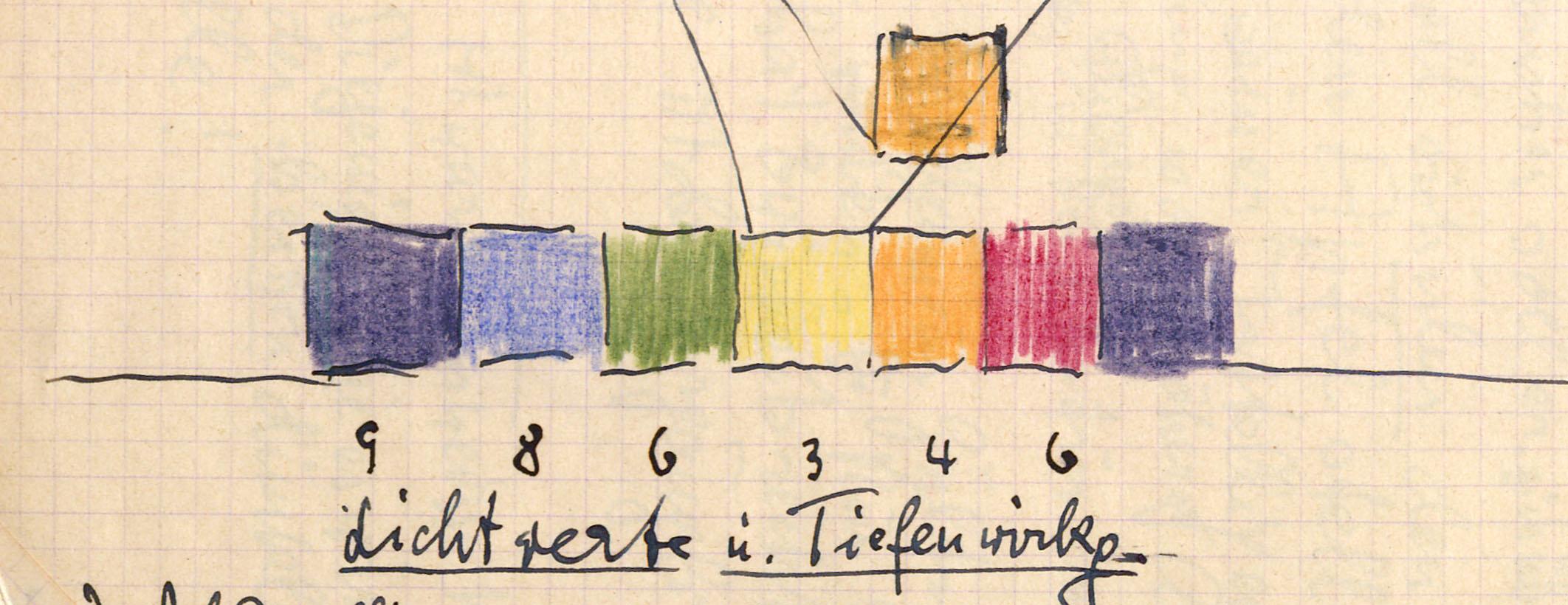
Johannes Itten
Johannes Itten was an important figure in Zurich’s post-war artistic and cultural life, whose teaching and theories on art have had an international influence. Join us on a journey via Vienna, Weimar, Berlin and the other places where Itten worked, ending in Zurich.
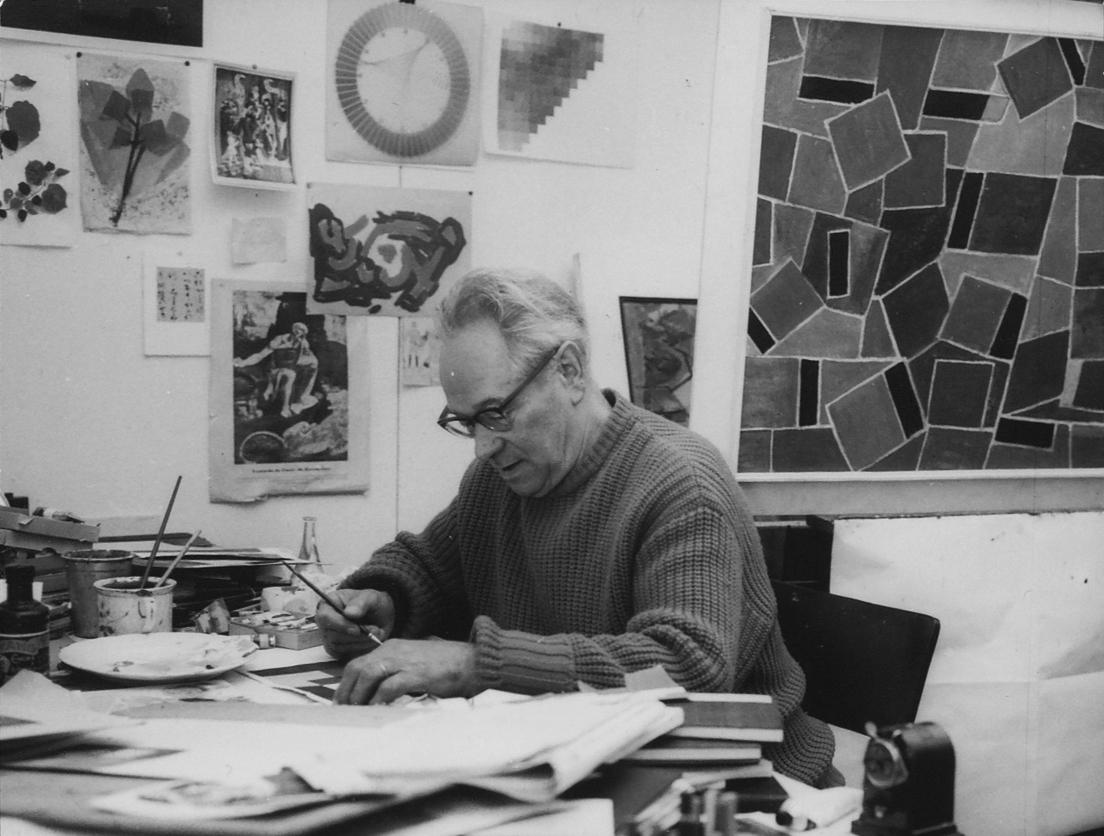
Johannes Itten in Zürich
Als sich Johannes Itten 1938 in Zürich niederliess, hatte der damals 50-Jährige bereits an vielen Orten gewirkt. Er kam nach Zürich, um die Direktion der Kunstgewerbeschule (heute Zürcher Hochschule der Künste) und des Kunstgewerbemuseums (heute Museum für Gestaltung) zu übernehmen. Ab 1943 besetzte er weiter auch die Leitung der Textilfachschule Zürich (heute Schweizerische Textilfachschule). Mit diesen Ämtern konnte Itten in Zürich die Arbeit weiterführen, die er 1938 in Deutschland auf Druck der Nationalsozialisten hatte aufgeben müssen.
In Zürich bot sich für Itten zudem die Gelegenheit, seine Beschäftigung mit ostasiatischer und afrikanischer Kunst unter Beweis zu stellen. Seit 1945 verhandelte er mit Baron Eduard von der Heydt über die Schenkung von dessen Sammlung aussereuropäischer Kunst an die Stadt Zürich. Itten richtete dafür das Museum Rietberg ein und bekleidete das Amt des Direktors bis 1956.
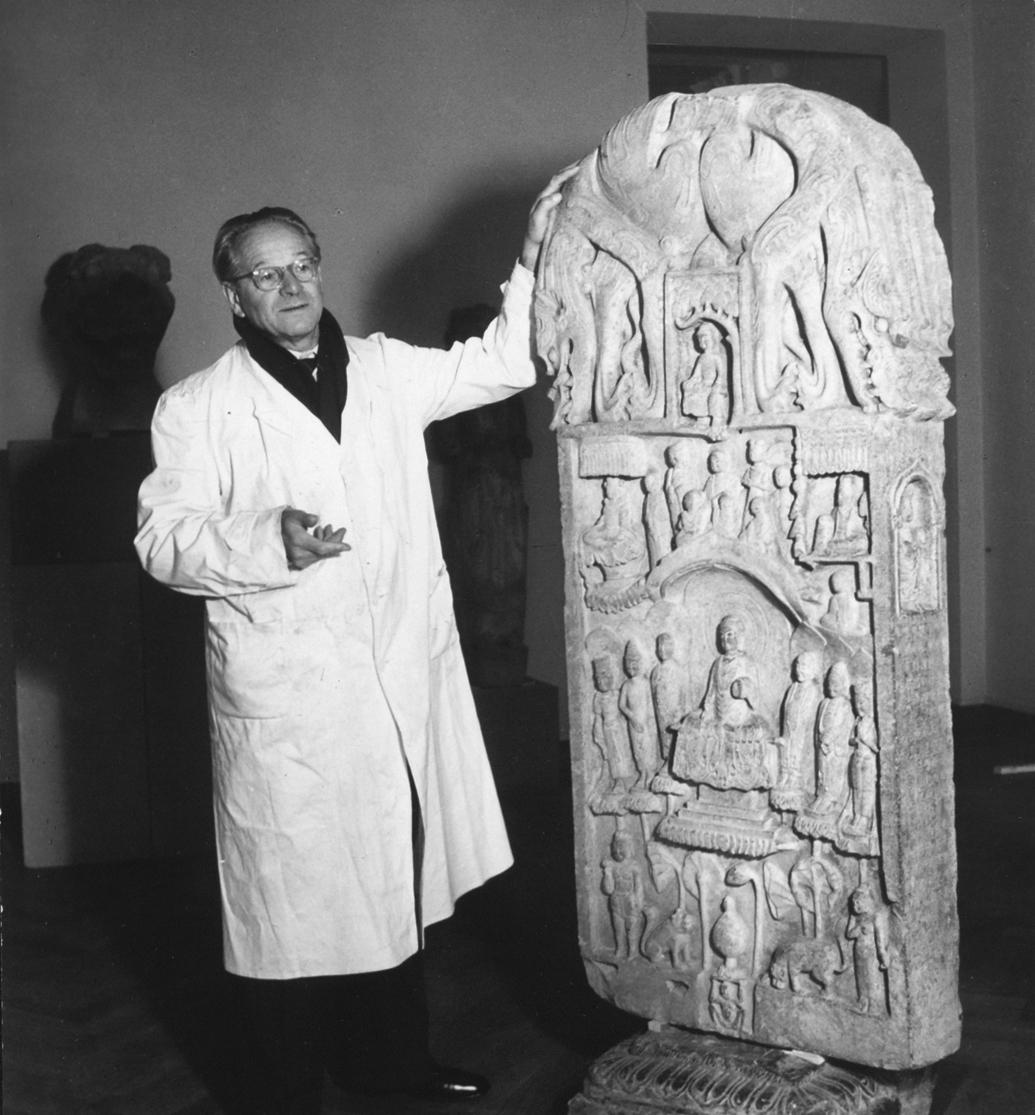
Nach seiner Pensionierung veröffentlichte Itten seine kunsttheoretischen Überlegungen und seine pädagogischen Konzepte in den erfolgreichen Büchern «Kunst der Farbe» und «Mein Vorkurs am Bauhaus». Die «Kunst der Farbe» wurde in den 1960er Jahren zum Bestseller und in viele Sprachen übersetzt.
Zürich war somit der Ort, wo Itten seine Kernkompetenzen, seine Erfahrungen und seine Interessen, die er an verschiedenen Lebensstationen entwickelt und gesammelt hatte, weiterführen und vollenden konnte.
In der aktuellen Forschung wird Ittens Wirken in Zürich in folgenden Projekten thematisiert:
Unter der Leitung von Prof. Thomas Sieber läuft derzeit an der Zürcher Hochschule der Künste ein Projekt, in dem Johannes Itten als Ausstellungsmacher und Museumsdirektor (im Kunstgewerbemuseum Zürich und im Museum Rietberg) unter dem Aspekt der kolonialen und nationalen Selbst- und Fremdkonzepte untersucht wird.
Am Lehrstuhl für Kunstgeschichte der Universität Regensburg wird unter Leitung von Prof. Dr. Christoph Wagner seit vielen Jahren der schriftliche Nachlass Johannes Ittens wissenschaftlich ausgewertet und ein Verzeichnis des künstlerischen Œuvres erstellt. Die Werke der Zürcher Jahre sind im Band II des Catalogue raisonné enthalten, der 2021 publiziert worden ist. Ittens Wirken in Zürich wird zudem in einer in Regensburg entstehenden Dissertation untersucht.
Drei Schwerpunkte – Pädagogik, aussereuropäische Kunst und die Farbenlehre – werden im Folgenden genauer betrachtet.
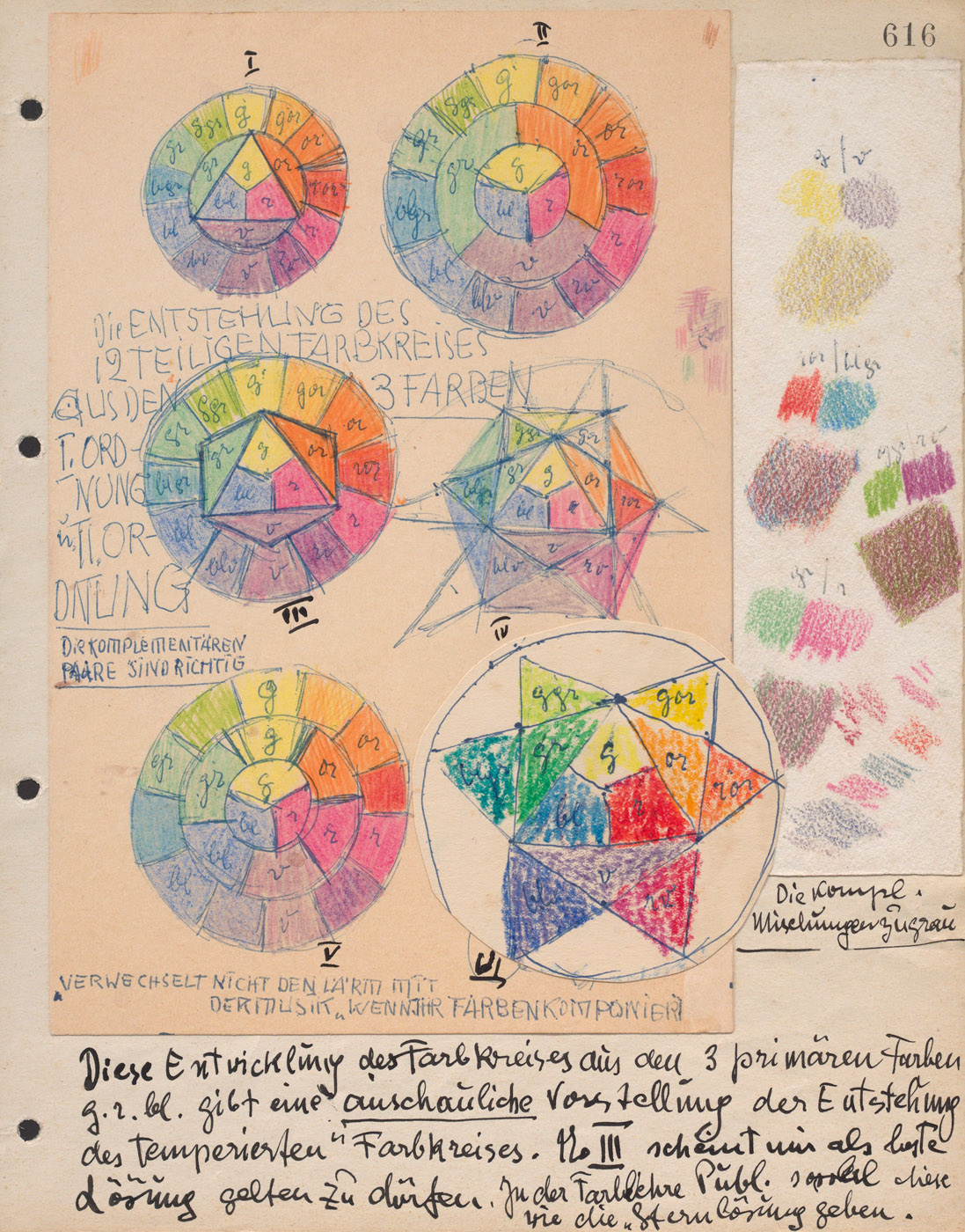 Digitalisat)">
Digitalisat)">
Pädagogik
Einer der zentralen Bestandteile von Ittens Kunstpädagogik ist der sogenannte Vorkurs. Dieses Probesemester entwickelte er über mehrere Jahrzehnte als Lehrer an diversen Bildungsanstalten, wie beispielsweise dem Bauhaus in Weimar. Stets erweiterte und verfeinerte er sein Bildungskonzept. 1939 führte er den Vorkurs auch an der Kunstgewerbeschule Zürich ein. Nicht nur dort, sondern auch an vielen anderen Kunstschulen, gehört er bis heute zum festen Bestandteil des Lehrplanes.
Der Grundgedanke ist dabei, dass die Schülerinnen und Schüler nicht einfach ein Repertoire von Formen und Regeln vermittelt bekommen, wie dies bis weit ins 20. Jahrhundert hinein an den Kunstakademien üblich war. Itten ging es darum, dass der Lernende selber schöpferisch tätig wird, dass sein Talent und seine Kreativität geweckt werden und sich entfalten können. Dabei standen das Experimentieren mit Materialien, die Befreiung von alten Vorbildern in der Kunst sowie das Finden einer eigenen Ausdrucksform im Zentrum.
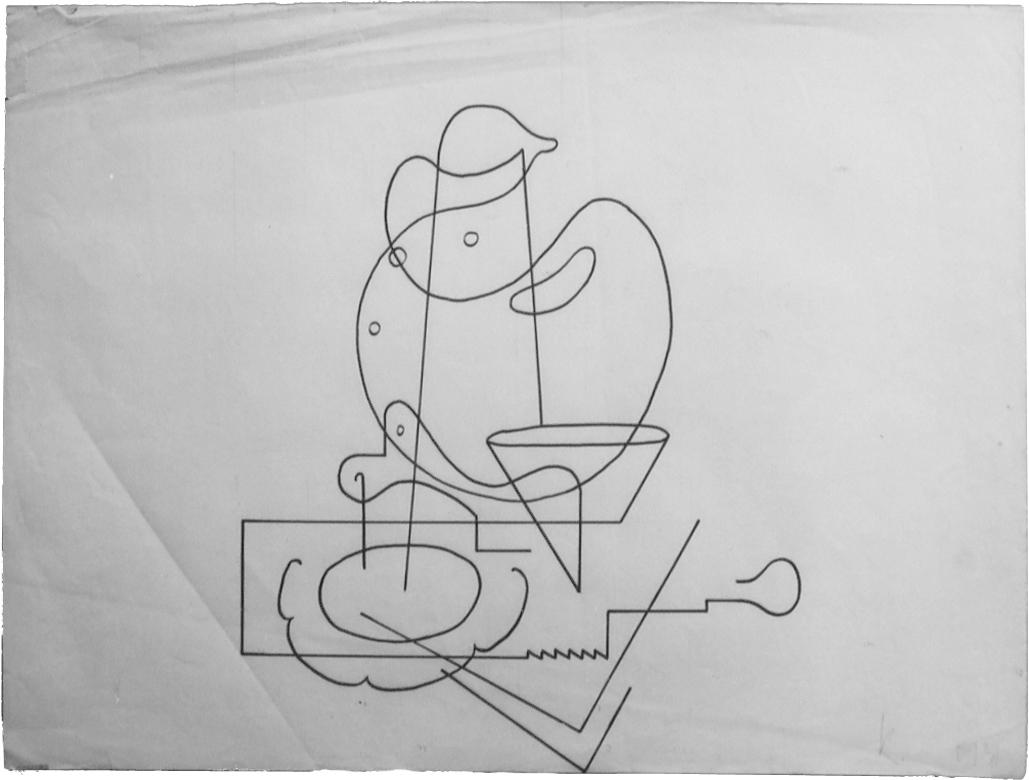
Aussereuropäische Kunst
Ittens Bemühungen um die aussereuropäische Kunst prägten Zürich nachhaltig: Dass das Museum Rietberg 1952 eröffnet werden konnte, ist Johannes Itten mitzuverdanken. Mit grossem Engagement hatte er sich dafür eingesetzt, dass die Sammlung von Baron Eduard von der Heydt in der Villa Wesendonck einen dauerhaften Ausstellungsort bekommen konnte. Bis 1956 leitete er das Museum Rietberg, das einzige Museum für aussereuropäische Kunst der Schweiz.
Auch als Direktor des Kunstgewerbemuseums präsentierte Itten immer wieder afrikanische oder asiatische Kunstwerke der Öffentlichkeit. Gerade mit ostasiatischer Kunst und Philosophie setzte sich Itten auch künstlerisch auseinander. Die posthume Ausstellung «Tuschezeichen», die 1988/1989 im Museum Rietberg Zürich und in Heidelberg gezeigt wurde, widmete sich genau diesem Aspekt von Ittens Schaffen.
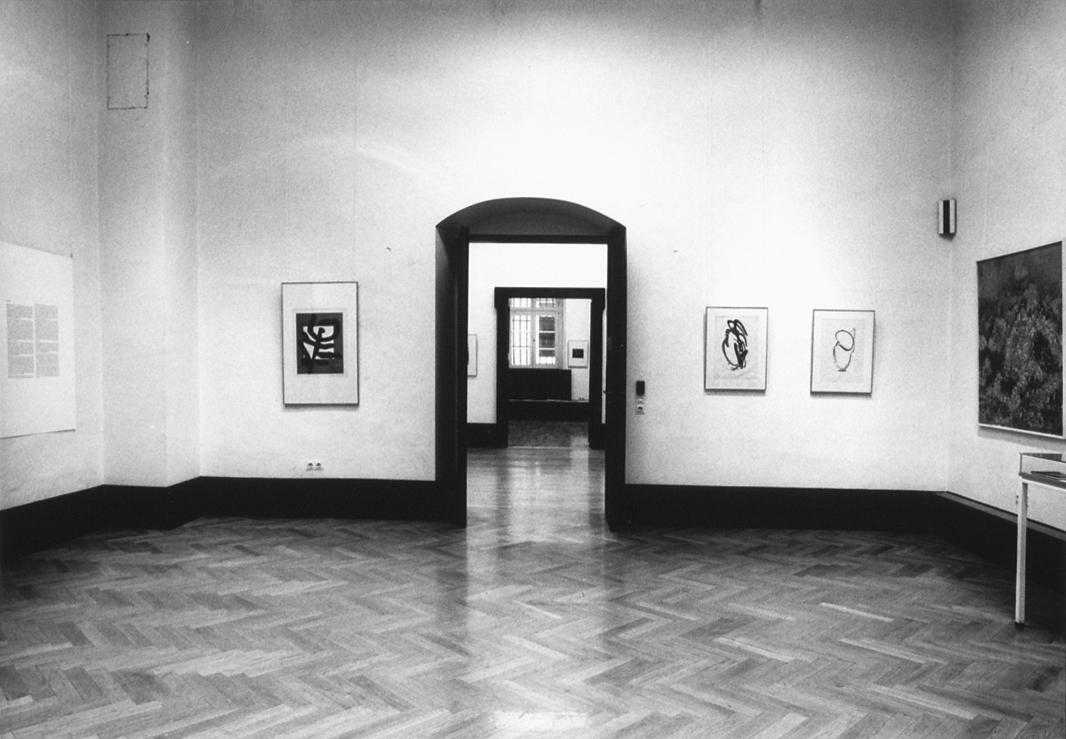
Farbenlehre
Nicht nur als Maler, sondern auch als Theoretiker beschäftigte sich Itten sein Leben lang mit der Farbe. Ganz besonders interessierten ihn die Gesetzmässigkeiten und Wirkungen von Farben. Seine eigenen Ideen bauen auf denen anderer Farbtheoretiker auf, darunter Philipp Otto Runge, Wilhelm von Bezold, Eugène Chevreul und Adolf Hölzel.
Im Zürcher Kunstgewerbemuseum präsentierte Itten seine farbtheoretischen Ideen im Jahr 1944 erstmals der Öffentlichkeit und stellte sie in den Kontext von Natur, Kunst, Wissenschaft und Technik. Der Drucklegung seiner Farbenlehre widmete er sich intensiv nach Eintritt in den Ruhestand 1956. 1961 konnte sein theoretisches Hauptwerk «Kunst der Farbe» im Otto Maier Verlag in Ravensburg erscheinen. Die Publikation wurde in zahlreiche Sprachen übersetzt und beförderte damit die internationale Rezeption Ittens. Noch heute wird Ittens Farbenlehre an Kunsthochschulen weltweit unterrichtet.
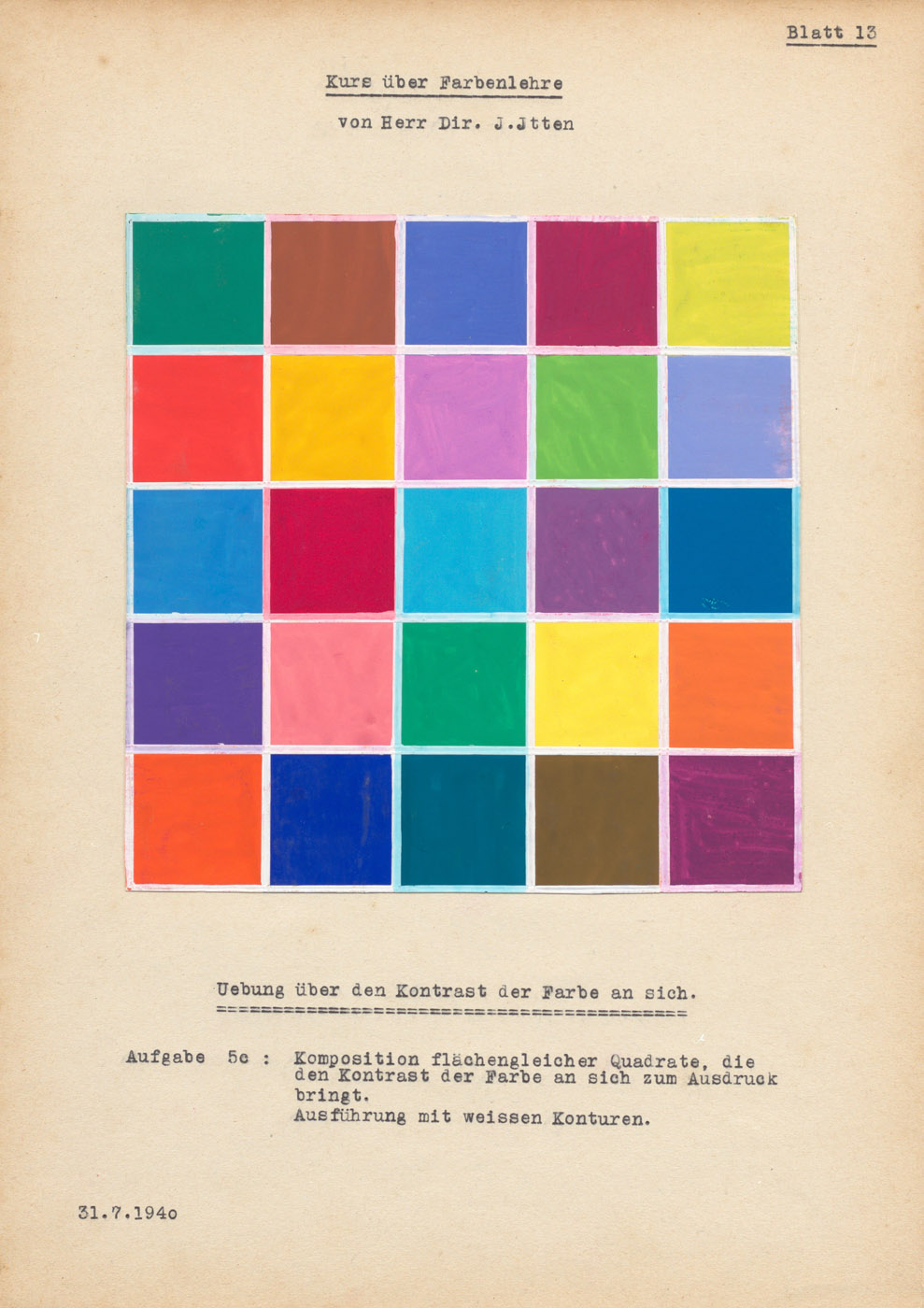 Digitalisat)">
Digitalisat)">
Lebenslauf
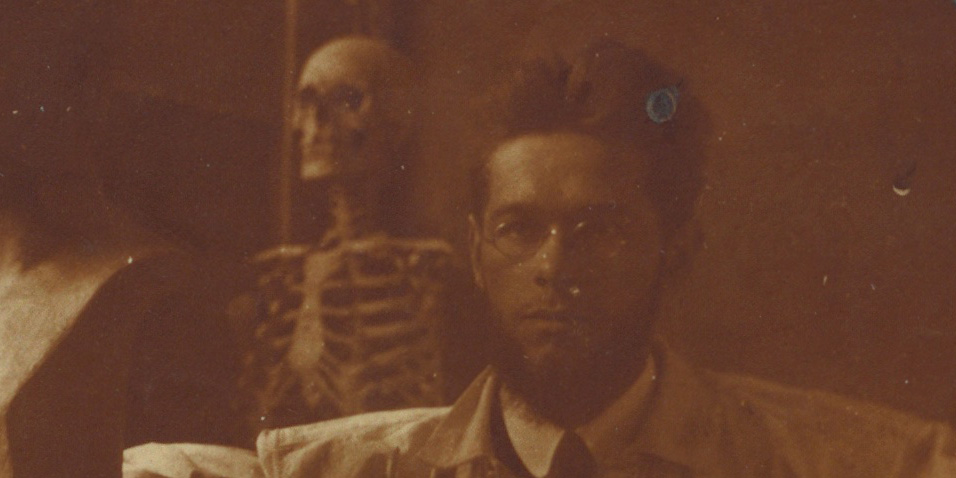
Thun, Bern and Geneva
Johannes Itten was born on 11 November 1888 in Süderen-Linden in the Bernese Oberland. Following his father’s death in 1892, he moved home frequently, but remained in a rural environment until he went to live with his uncle in Thun at the age of 10. Itten wanted to be a teacher like his late father, and so attended teacher training college in Hofwil near Bern. He also took drawing lessons and studied the methods of progressive education. After working for a little over a year as a village schoolmaster, he made a speculative application to the École des Beaux-Arts in Geneva to study art. He returned to Bern in 1910, without completing his studies, to become a secondary school teacher. Thereafter he travelled to cities including Paris, Munich, Cologne and Mannheim, where he visited the great art exhibitions of the day. He then decided to study for a further semester at the École des Beaux-Arts in Geneva. Itten’s interest in, and aptitude for, art and teaching were already becoming evident.
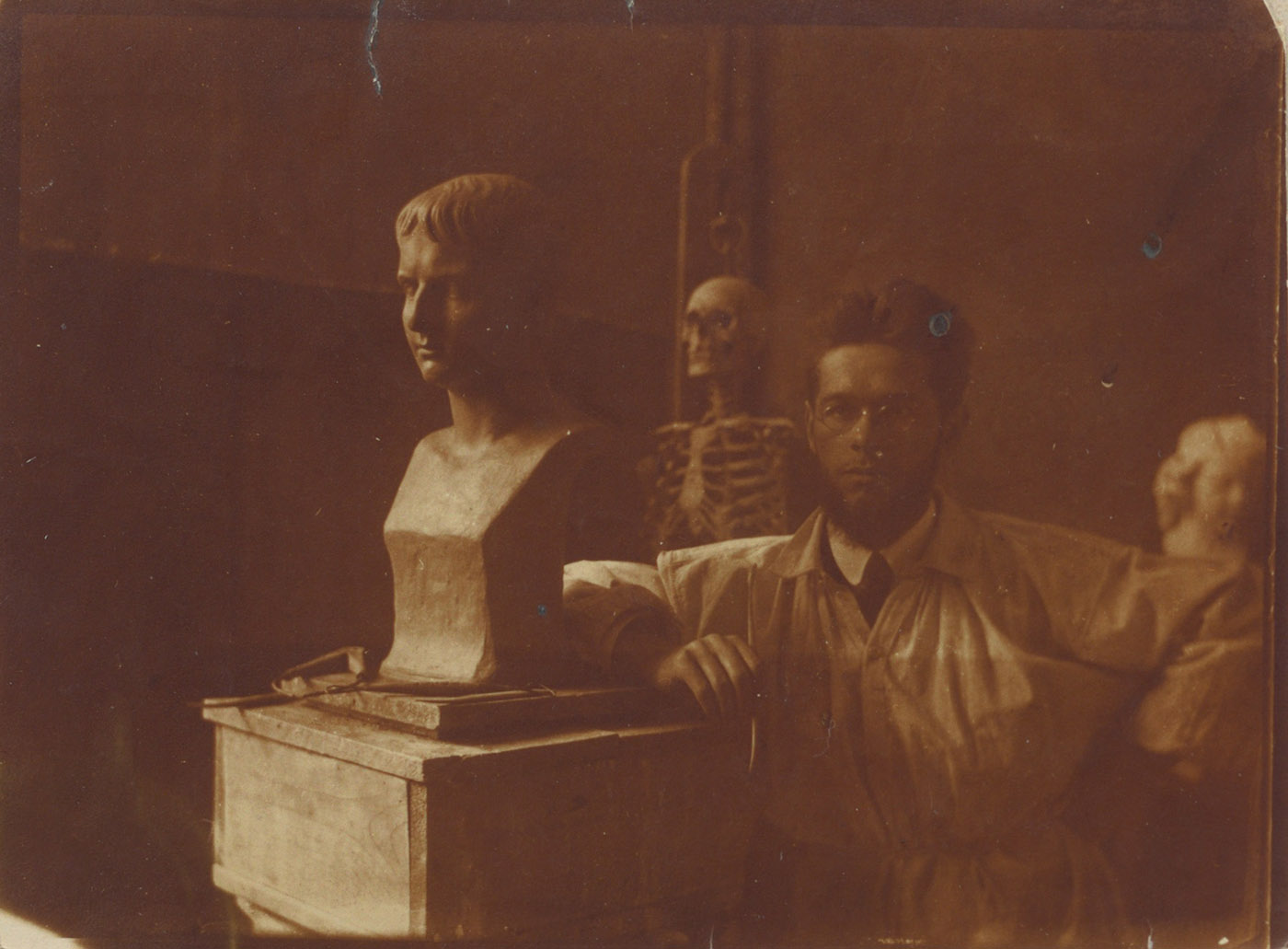
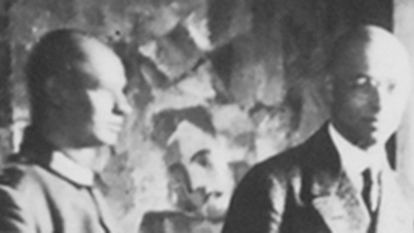
Stuttgart
After seeing a painting by Adolf Hölzel in Munich, Itten resolved to travel to Stuttgart and study under Hölzel at the Academy of Fine Arts. He was accepted into Hölzel’s masterclass in 1914. Hölzel’s theory of contrast, his investigations into the laws underlying the construction of artworks, and his colour theory greatly influenced Itten’s own work. Itten studied Expressionism and Cubism and created his early abstract image compositions.
Itten was also inspired by his exchanges with fellow artists Ida Kerkovius, Oskar Schlemmer, Willi Baumeister and Hermann Stenner.
In 1916, on Hölzel’s recommendation, Itten began giving private drawing lessons.
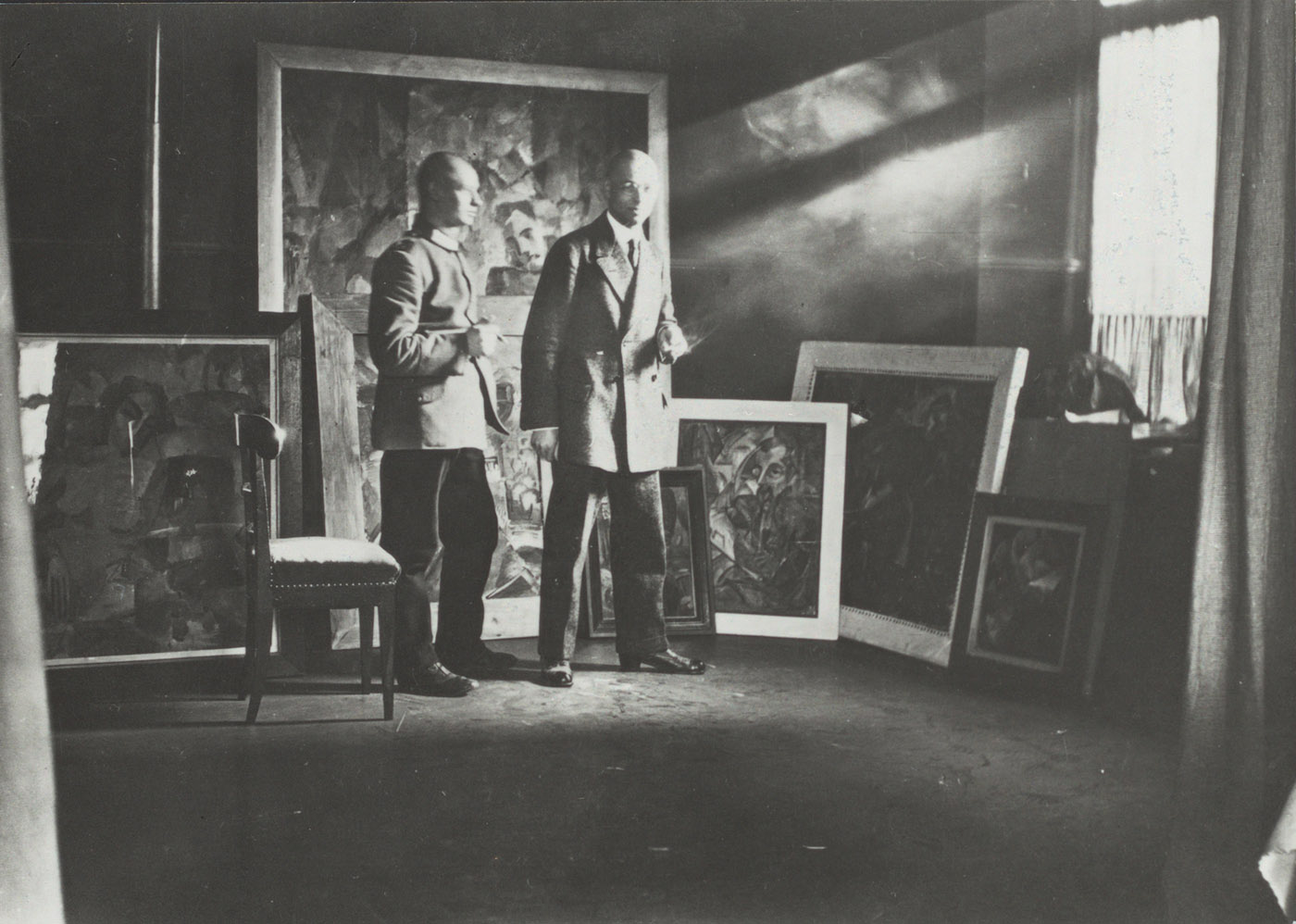
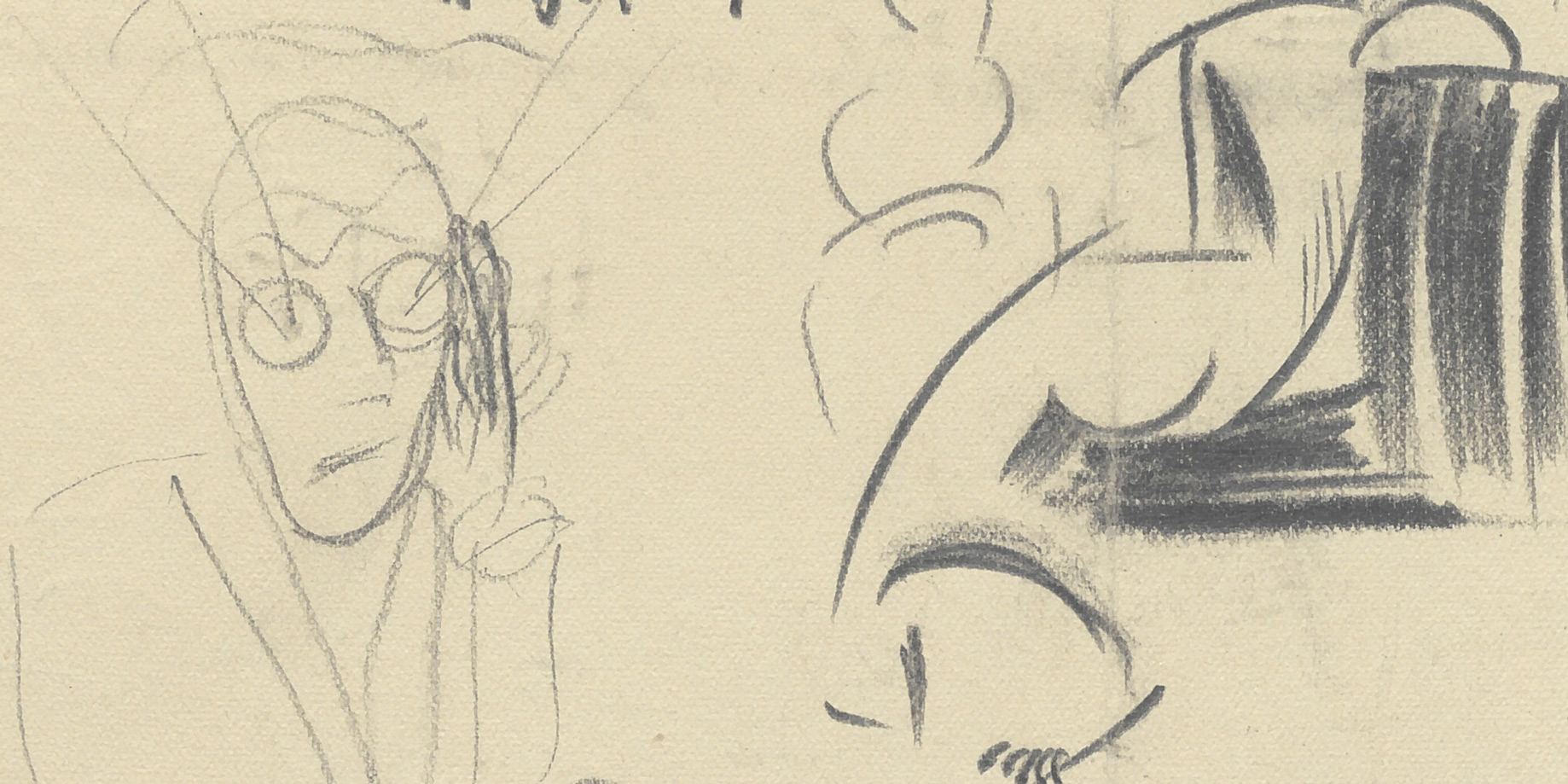
Vienna
Encouraged by his pupil Agathe Mark, Itten left Stuttgart for Vienna in 1916. There, he pursued his non-representational art and continued giving private art lessons – so successfully, in fact, that the number of students steadily increased and Itten switched from giving private tuition to teaching classes.
During this period, he made an extensive study of theosophical and other esoteric writings, and frequented the art and avant-garde circle of Alma Mahler. There he met artists, musicians, architects and literary figures such as Adolf Loos, Josef Matthias Hauer, Gustav Klimt and Oskar Kokoschka as well as Hildegard Anbelang, who later became his wife. It was Alma Mahler who persuaded her then husband Walter Gropius, Director of the newly founded Bauhaus in Weimar, to employ Itten at the Bauhaus. According to Itten she said to Gropius: “Walter, if you want to make something of your Bauhaus idea, you must recruit Itten!”
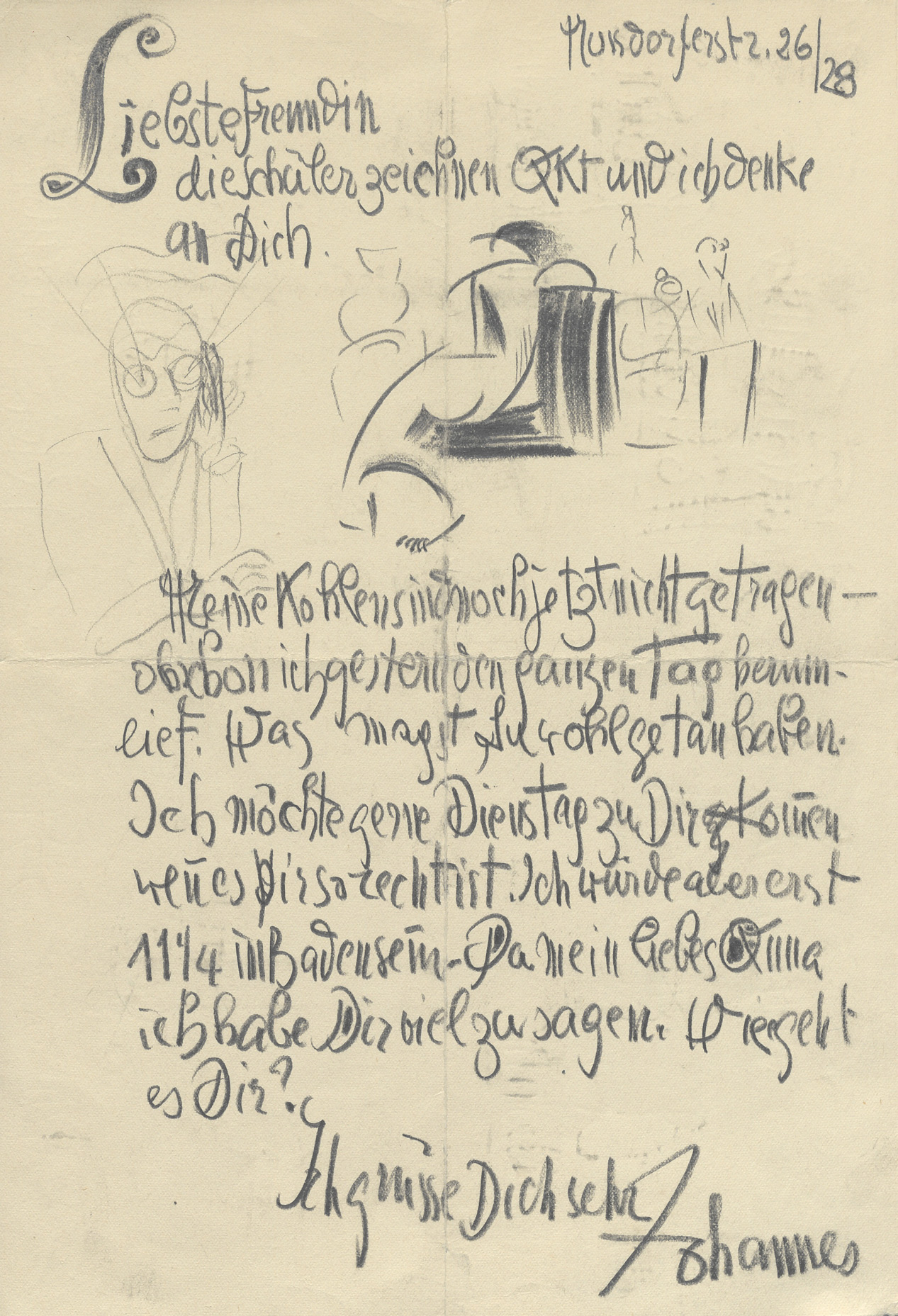
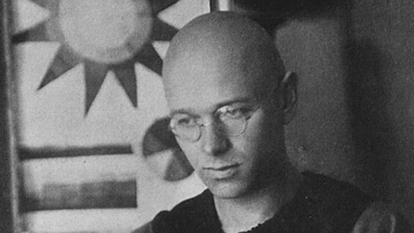
Bauhaus in Weimar
Itten accepted Gropius’s invitation to join the new art school in Weimar. There he introduced the preliminary course, a trial semester during which students were given the chance to explore the means of creating pictures in depth and work in unconventional ways.
Itten ran various workshops as a form master at the Bauhaus. He taught his celebrated preliminary course in the Henry-van-der-Velde building. He installed his studio in the Tempelherrenhaus, a neo-Gothic building in the Park an der Ilm. Here, he also had his students perform breathing and concentration exercises as well as yoga, in accordance with his social reformist ideas.
Artistically, Itten moved further and further away from non-representational painting and instead produced figural and representational works such as his famous “Kinderbild” on the birth of his son Matthias in 1920.
At the Bauhaus in Weimar, he also continued his investigations into colour theory and designed his celebrated colour sphere, also known as the colour star, in seven light values and twelve tones.
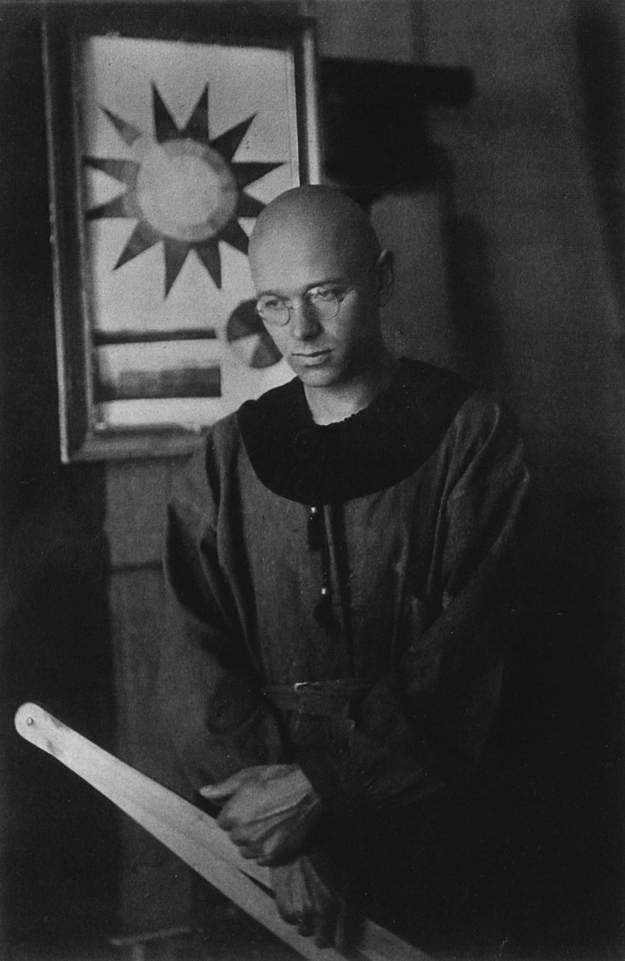
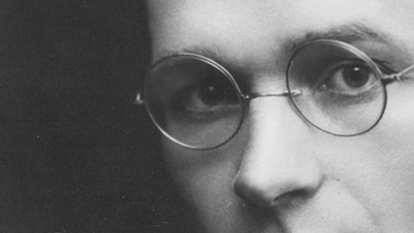
Herrliberg
Itten left his post as a master at the Bauhaus at the end of 1922, in the wake of growing differences with its Director Walter Gropius. He turned his back on Germany and settled with his family among the international Mazdaznan temple community in Herrliberg. There, he devoted himself entirely to the Mazdaznan teachings. These combined ideas of vegetarianism and a theory of breathing and hygiene with a religious philosophy that sought to unite Eastern wisdom with Christian messages of salvation.
Itten created the Ontos hand weaving and carpet-making workshops within the community in Herrliberg, where he also taught art.
Gradually, however, tensions emerged within the community over moves to reorient the Mazdaznan movement. As a result, Itten left Herrliberg for Berlin in October 1925.
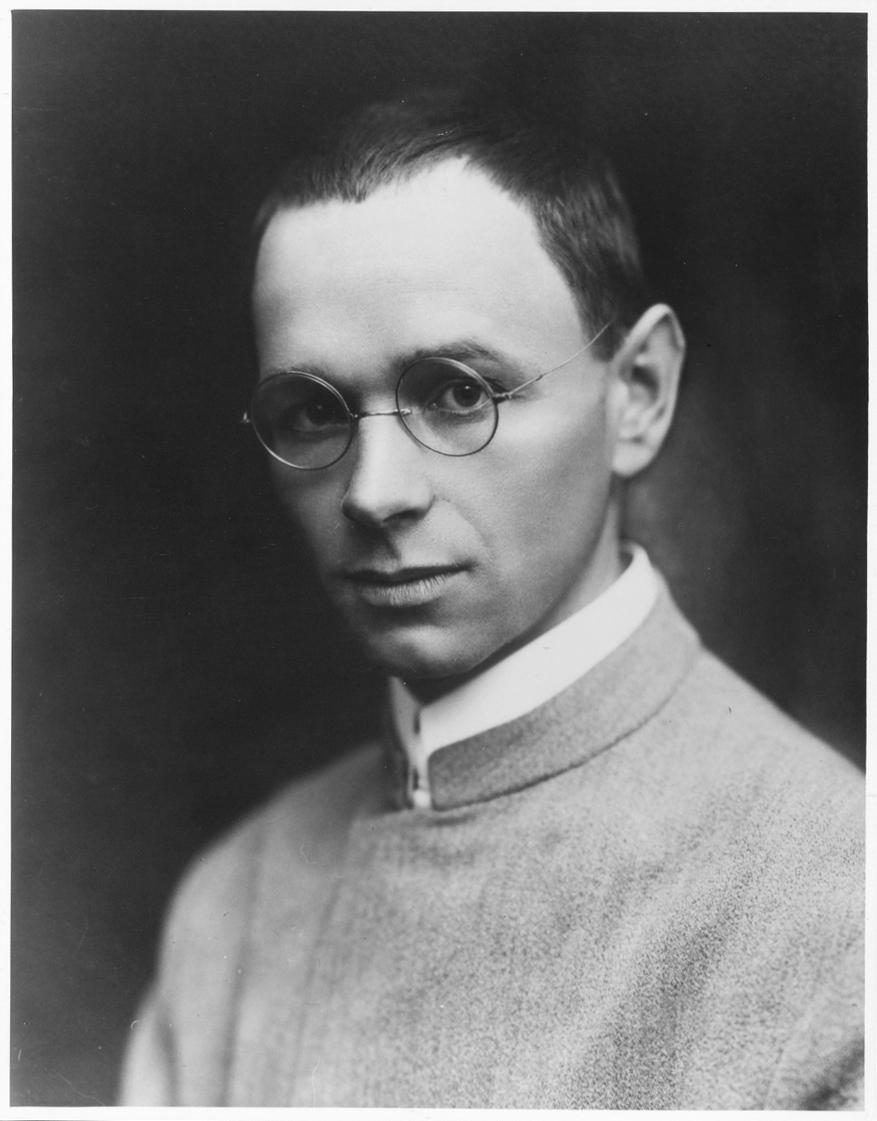
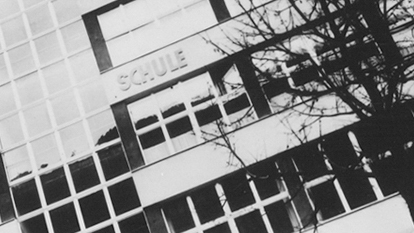
Berlin
In Berlin, Itten established his own private art school – the Itten School – which quickly became very successful and a serious rival to the Bauhaus. At the end of 1929, Itten moved his school to a recently constructed building very much in the “Neues Bauen” style, with a large roof terrace for gymnastics and breathing exercises.
As with the Bauhaus, the main aim of his school was not to train independent artists but to tutor creative artists for practical occupations as photographers, architects, advertising and pattern designers. Former Bauhaus students worked as teachers in Itten’s school; they included Georg Muche, Gyula Pap, Lucia Moholy and Max Bronstein. In April 1934, the Itten School followed the Bauhaus in closing down under pressure from the Nazis.
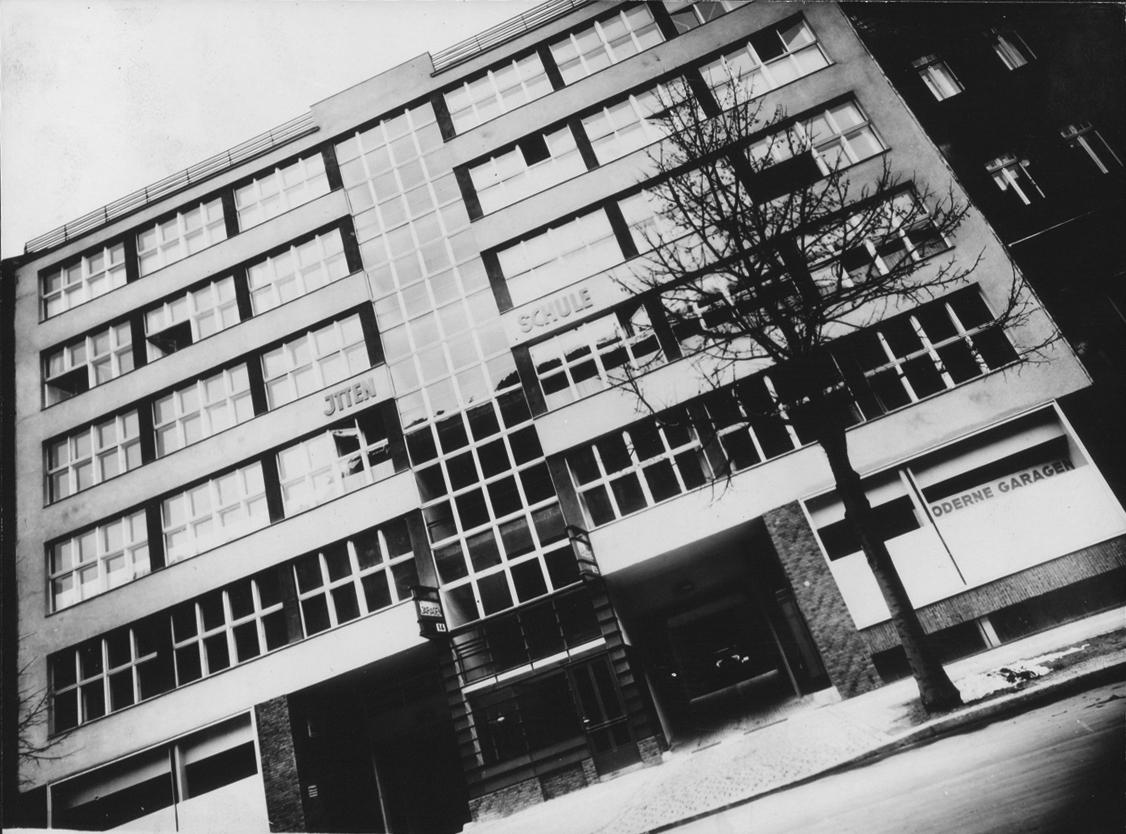
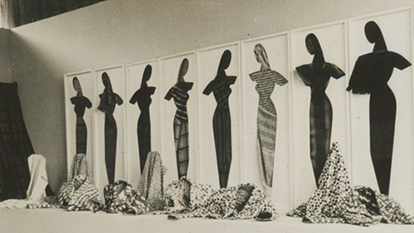
Krefeld
In 1931, Itten was appointed by the Krefeld velvet and silk industry as Director of the Textile School, holding the post while continuing his work in Berlin. The Prussian School of Textile Art Krefeld, as it was officially known, was transformed by Itten from a vocational school of textile art with a purely technical approach to an art college where textile designers were trained. It was also here that he met his second wife Anneliese Schlösser, a former pupil and later teacher of pattern weaving.
In 1938, Itten was dismissed from his post, having fallen under suspicion for being both a foreigner and a former associate of the Bauhaus. The “Degenerate Art” exhibition that was staged in Munich in summer 1937 during the Nazi dictatorship included two pieces by him. Itten was regarded as a “degenerate” artist, and his works were removed from public collections in Germany.
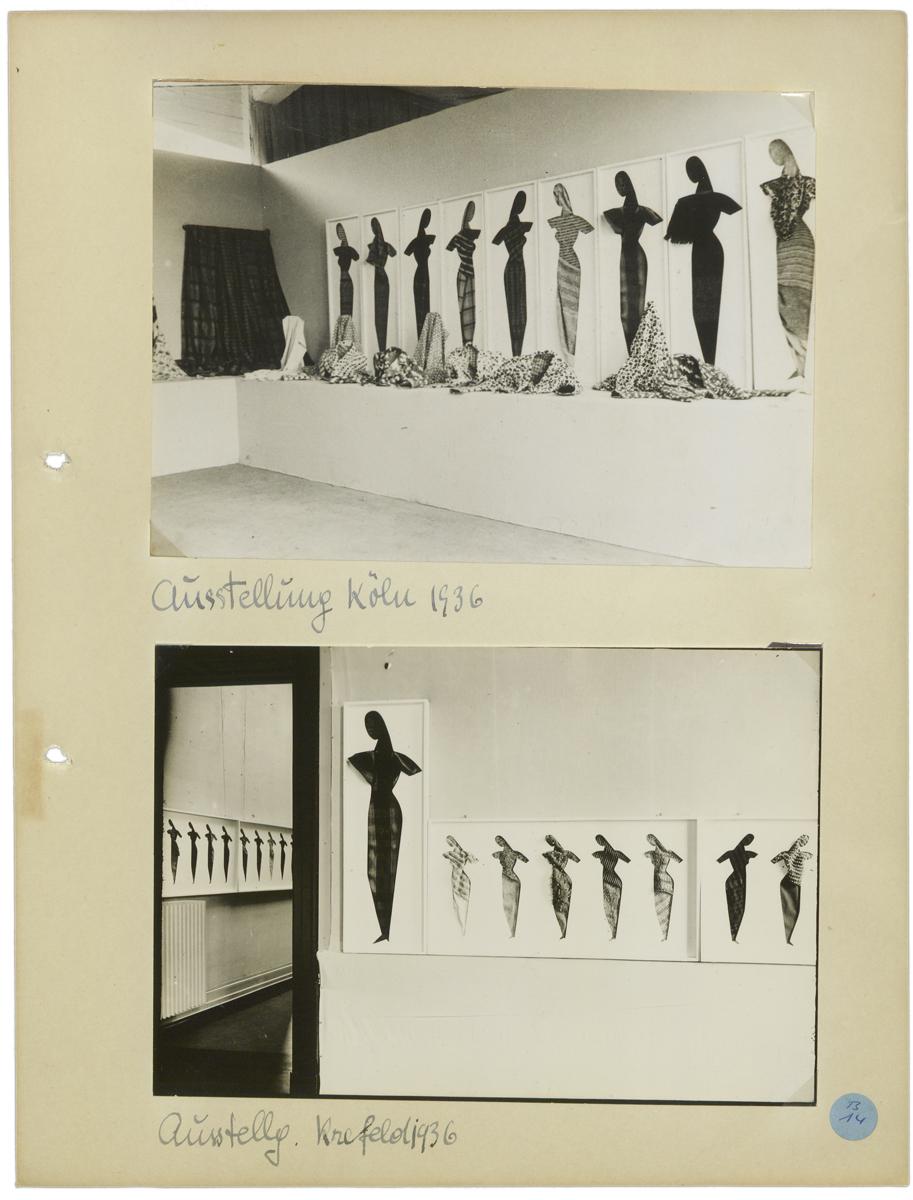
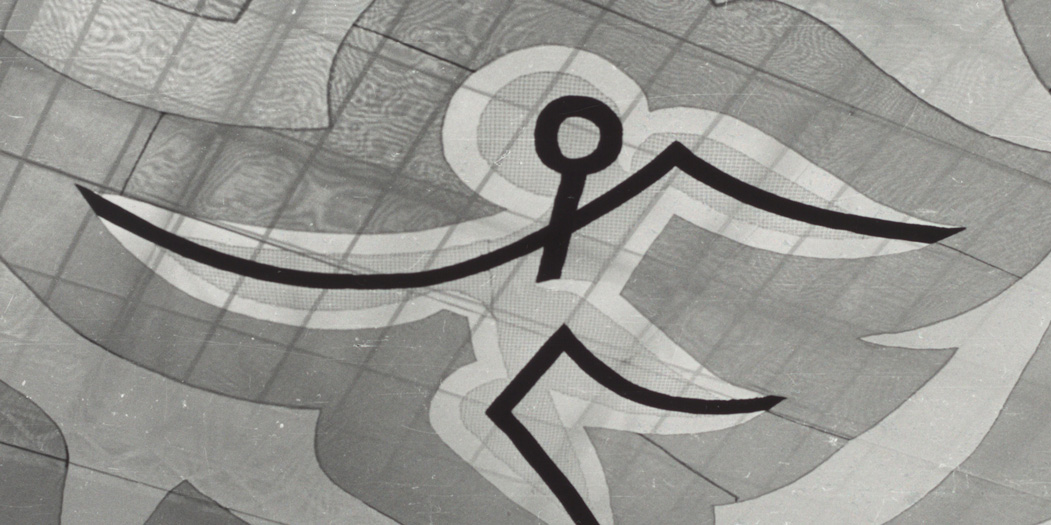
Amsterdam
Following his dismissal, Itten left Germany and began searching for new occupations, mainly in America. Initially, however, he went to Amsterdam, where he eked out a living giving painting lessons and lectures. Itten viewed his stay in the Netherlands as no more than a temporary stopover on his way to the US. Soon, however, he was commissioned by Willem Sandberg, Director of the Stedelijk Museum in Amsterdam, to design a large cloth – a velum – for the glass roof of the museum’s entrance hall. Itten created a textile work of art that gained widespread fame but is no longer preserved.
While still in Amsterdam, Itten heard from the Swiss art historian Sigfried Giedion that the position of Director of the School of Arts and Crafts Zurich and the Arts and Crafts Museum was vacant, and sent in his application.
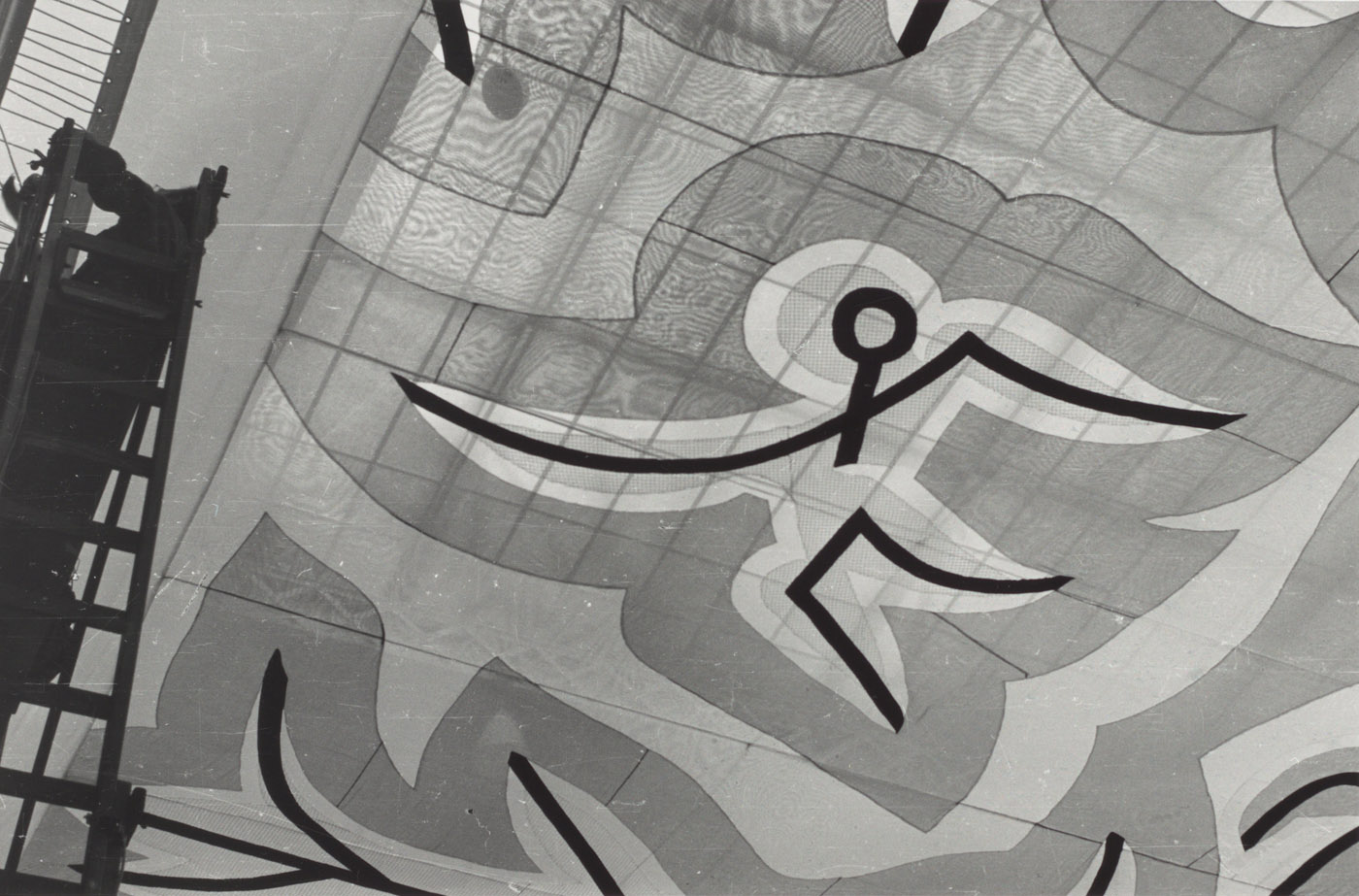
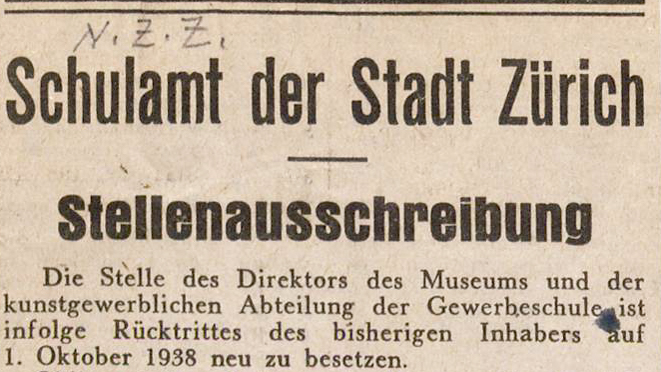
Zürich
Having been successful in his application to the School of Arts and Crafts Zurich and the Arts and Crafts Museum, Itten took up his new post as Director of both institutions in December 1938 and remained there until his retirement.
In 1939, he began teaching his form and colour theory in the general preparatory course. His lessons were designed to liberate the students’ creative forces and nurture their individual gifts. This intellectual approach characterised the School of Arts and Crafts Zurich throughout Itten’s term of office.
In 1943, he also took over as Director of the Zurich Textile School. By the time he left, the school of silk weaving had become a specialist college, training new recruits for the various branches of the textile industry: master weavers as well as textile technicians, salespeople and designers. From the 1950s onwards, the development of the Museum Rietberg allowed Itten to pursue the strong interest in non-European art that had been a constant since the start of his career.
Following his retirement, Itten focused on getting his two successful theoretical works “The Art of Colour” and “Basic Course at the Bauhaus” published; the former appeared in 1961, the latter in 1963. A retrospective at the Kunsthaus Zürich in 1964 and his participation in the Venice Biennale in 1966 brought him wide recognition. Johannes Itten died in Zurich in 1967 and was buried in Höngg Cemetery.
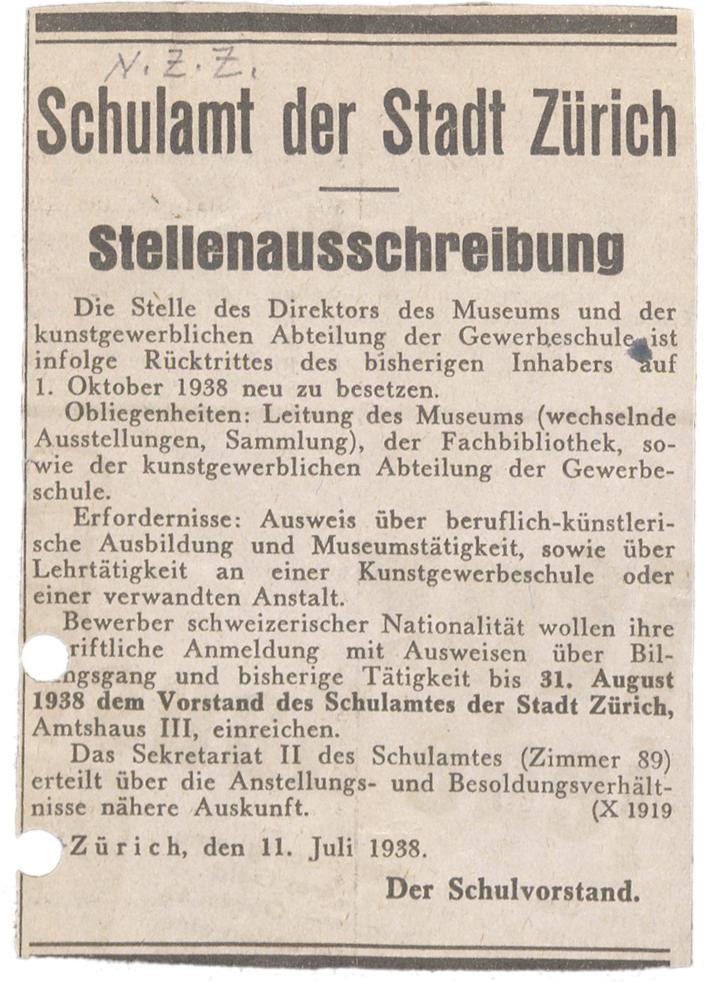
Nachlass
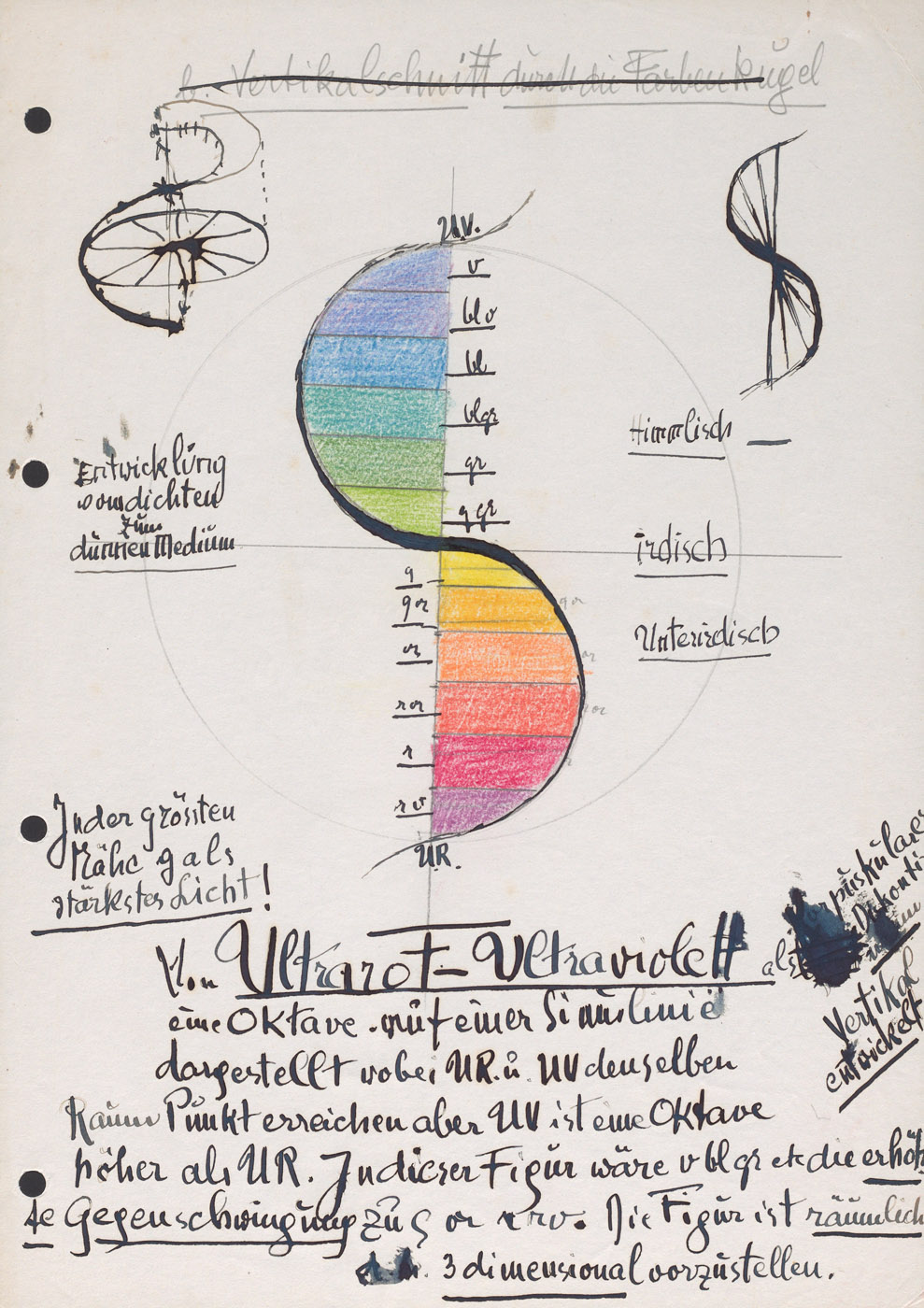 Digitalisat)">Der schriftliche und kunsttheoretische Nachlass Johannes Ittens befindet sich in der Zentralbibliothek Zürich. Dieser wurde im Rahmen des Projekts «Itten vernetzt» für die Forschung erschlossen und bereitgestellt. Die Dokumente können über das Archivportal ZBcollections online recherchiert und vorbehaltlich rechtlich und konservatorisch bedingter Zugangsbeschränkungen im Lesesaal der Handschriftenabteilung eingesehen werden.
Digitalisat)">Der schriftliche und kunsttheoretische Nachlass Johannes Ittens befindet sich in der Zentralbibliothek Zürich. Dieser wurde im Rahmen des Projekts «Itten vernetzt» für die Forschung erschlossen und bereitgestellt. Die Dokumente können über das Archivportal ZBcollections online recherchiert und vorbehaltlich rechtlich und konservatorisch bedingter Zugangsbeschränkungen im Lesesaal der Handschriftenabteilung eingesehen werden.
Weitere bedeutende Bestände zu Johannes Itten sind in folgenden Institutionen zu finden:
Zürich
- Archiv des Museums Rietberg: Gründungsakten des Museums; Korrespondenz zwischen Johannes Itten und Eduard von der Heydt
- Archiv der Zürcher Hochschule der Künste: Dokumente der Kunstgewerbeschule und des Kunstgewerbemuseums Zürich, teilweise digital verfügbar im eMuseum.
- Schweizer Radio und Fernsehen (SRF): Beiträge zu Johannes Itten in Radio und Fernsehen, recherchierbar über Memobase
- Staatsarchiv des Kantons Zürich: institutionelle Dokumente der Textilfachschule Zürich
- Stadtarchiv Zürich: weitere Teilbestände des Museums Rietberg, der Kunstgewerbeschule und des Kunstgewerbemuseums Zürich
Bern
- Johannes-Itten-Stiftung (Sitz im Kunstmuseum Bern): künstlerische Tagebücher und frühe Werke Johannes Ittens
Ausland
- Bauhaus-Archiv Berlin: Korrespondenz zwischen Johannes Itten und Walter Gropius; institutionelle Dokumente des Bauhauses Weimar und Dessau
- Deutsches Textilmuseum Krefeld: Stoffe und damit in Verbindung stehende Dokumente und Objekte sowie Studien aus dem Unterricht (Schenkung Anneliese Itten)
- Klassik Stiftung Weimar: Prototypen der Möbelentwürfe Johannes Ittens
- Stedelijk Museum Amsterdam: Dokumente zu Ittens bekanntem textilen Kunstwerk «Velum»
Ein dreibändiges Werkverzeichnis mit weiterführenden wissenschaftlichen Informationen gibt einen vollständigen Überblick über das künstlerische Werk und den künstlerischen Nachlass Johannes Ittens: Band I zu den Werken von 1907 bis 1938 erschien zum Bauhaus-Jubiläumsjahr 2018, Band II zu den Werken aus den Zürcher Jahren 1939 bis 1967 im Herbst 2021 und Band III zu den textilen Arbeiten, Plastiken und kunsttheoretischen Schriften folgt 2023. Ab 2023 wird der Catalogue raisonné zudem als digitales Werkverzeichnis auf arthistoricum.net zugänglich sein.
Itten-Bibliothek
Die ZB verwahrt nicht nur den bedeutenden schriftlichen Nachlass Ittens, sondern auch die Itten-Bibliothek. In diesem Bestand von über 2000 Büchern und Broschüren sind Ittens Privatbibliothek, Ausgaben und Übersetzungen seiner Schriften, Ausstellungskataloge, Widmungsexemplare und Sekundärliteratur vereint. Zahlreiche Bände tragen Lese- und Gebrauchsspuren wie Adressangaben, Kauf- und Besitzinformationen, Widmungen, Randbemerkungen, Unterstreichungen und Zeichnungen.
Hinweise zur Recherche: Die Bücher und Broschüren der Itten-Bibliothek sind über swisscovery findbar. Bei einer Suche nach der Signatur «Itten» und einer Einschränkung des Suchbereiches auf die Zentralbibliothek Zürich werden sämtliche Exemplare angezeigt. Eine voreingestellte Suchabfrage finden Sie unter diesem Link.
Bei Vorliegen eines Benutzerausweises können die Bände anschliessend direkt via swisscovery bestellt und innerhalb einer angegebenen Frist im allgemeinen Lesesaal oder Rara-Lesesaal eingesehen werden.
Für inhaltliche Fragen zur Itten-Bibliothek kontaktieren Sie PD Dr. Lothar Schmitt, Fachreferent für Kunstgeschichte.
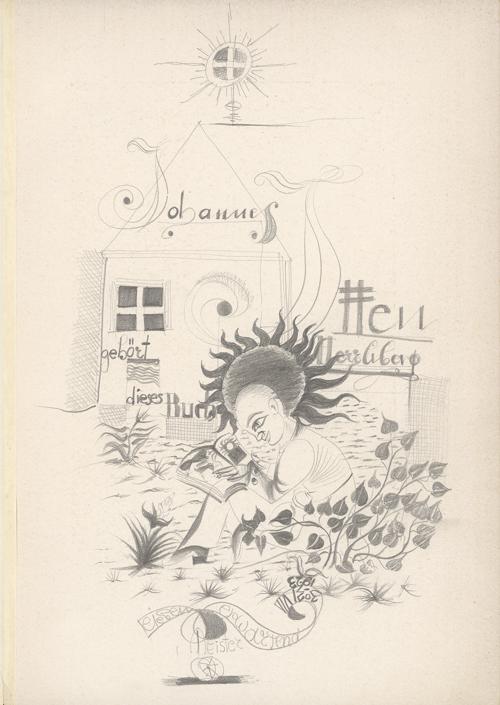
Projekt «Itten vernetzt»
Im Rahmen des Projektes «Itten vernetzt» wurden die Dokumente im Itten-Archiv geordnet, konservatorisch geprüft und behandelt, archiviert und im digitalen Katalog (ZBcollections) beschrieben. Forschende können die Dokumente vorbehaltlich rechtlicher und konservatorischer Einschränkungen im Lesesaal der Handschriftenabteilung einsehen und Digitalisate bestellen.
In der zweiten Projektphase wurde eine Linked-Open-Data-Wissensplattform entwickelt, das Johannes Itten Linked Archive (JILA). Mit zusätzlichen Kontextinformationen und neuen Suchmöglichkeiten werden historisch und kunstwissenschaftlich Forschende besser unterstützt bei Ihrer Recherche im Bestand. Diese Plattform basiert auf offenen vernetzten Daten und Digitalisaten des Itten-Archivs, enthält Verknüpfungen zum digitalen Itten-Werkverzeichnis und steht über eine graphische Oberfläche den Forschenden zur Verfügung. Dokumente in JILA wurden zunächst auf e-manuscripta öffentlich verfügbar gemacht.
Für die technische Entwicklung arbeitete die ZB mit der Swiss Art Research Infrastructure (SARI) an der Universität Zürich zusammen. Zudem kooperierte die ZB für dieses Projekt mit dem Lehrstuhl für Kunstgeschichte an der Universität Regensburg und dem Fachinformationsdienst Kunst an der Universitätsbibliothek Heidelberg.
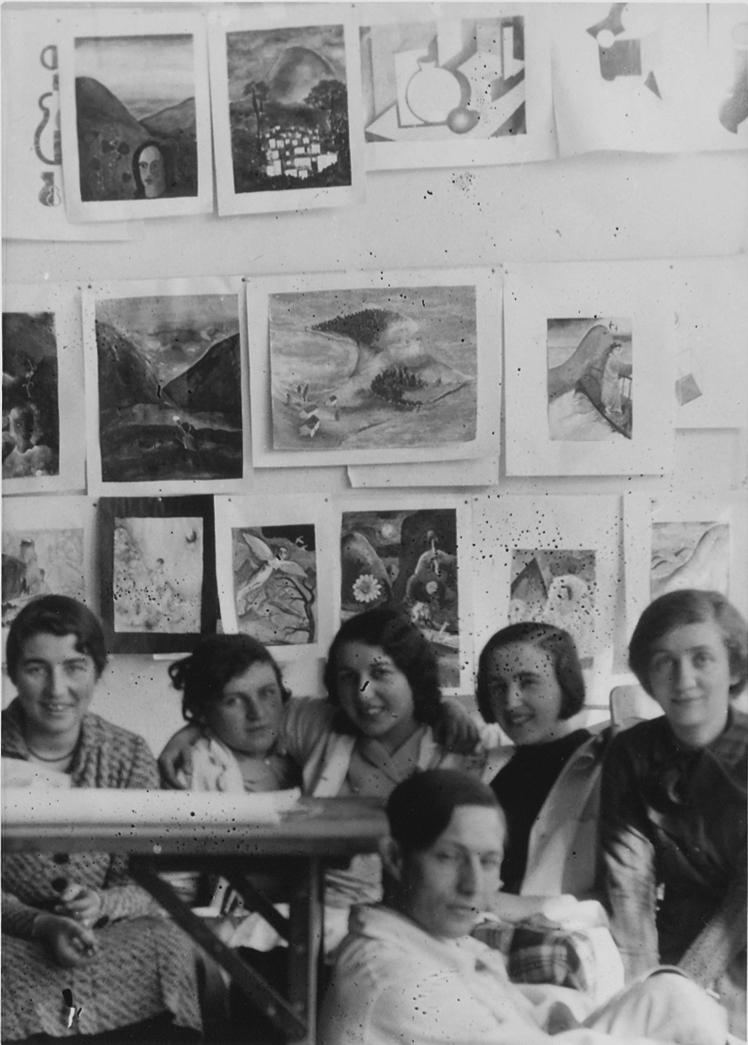
Literatur über Johannes Itten
Auf arthistoricum.net ist eine umfassende Bibliografie zu Johannes Itten online verfügbar. Die Bibliografie erfasst Forschungsliteratur zu Leben, Werk, Umfeld und Einfluss Ittens und wird regelmässig ergänzt.
Bild- und Textrechte
Bildrechte für den Abdruck künstlerischer Werke Johannes Ittens sind für die Schweiz bei ProLitteris einzuholen, für andere Länder bei der jeweiligen Verwertungsgesellschaft. Die Nutzung von urheberrechtlich geschützten Dokumenten aus dem Itten-Archiv für Ausstellungen, Publikationen u.a. bedarf einer Genehmigung. Weitere Informationen können über die Handschriftenabteilung der Zentralbibliothek Zürich eingeholt werden.
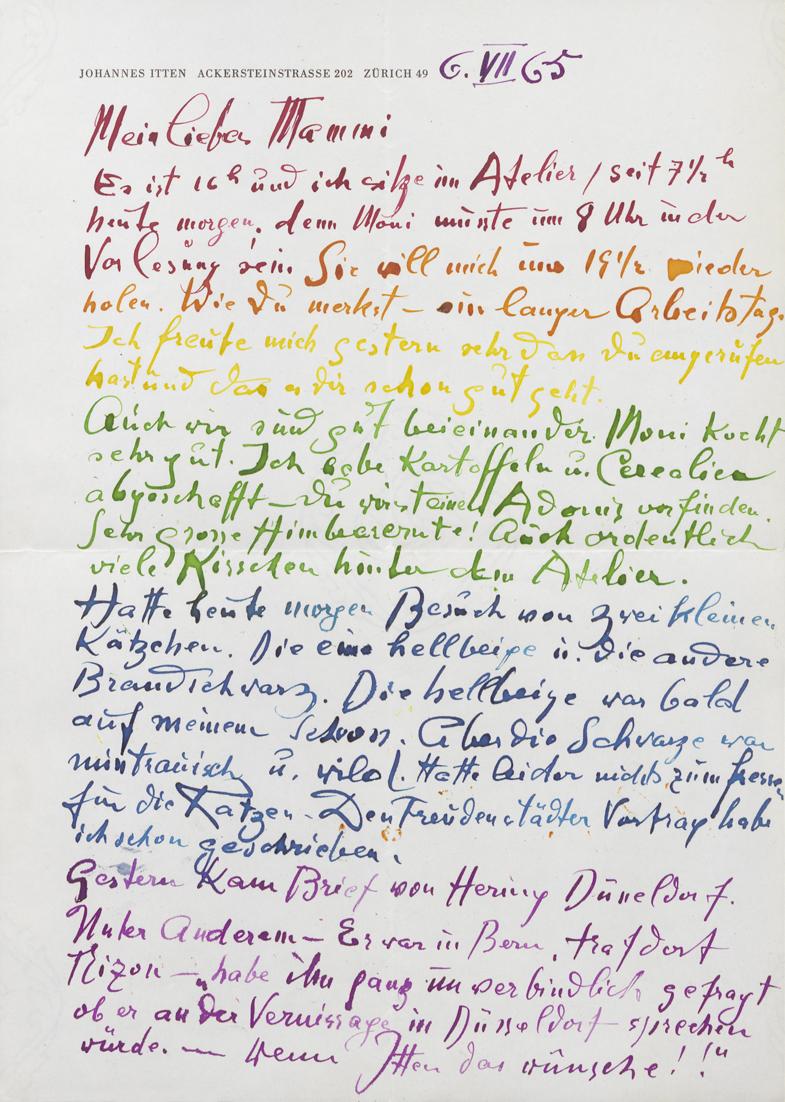
Kontakt
Bei Fragen ist die Handschriftenabteilung der Zentralbibliothek Zürich für Sie da.
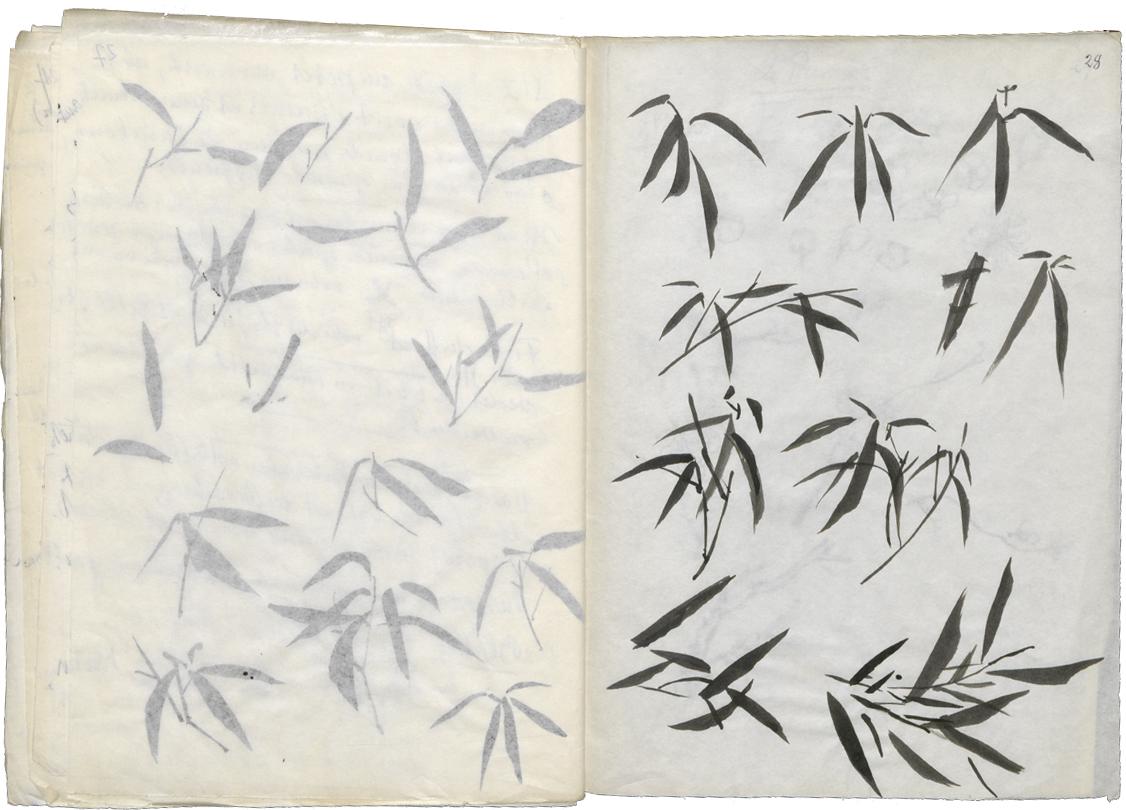
Bildnachweise
Sämtliche Abbildungen auf dieser Website stammen aus dem Itten-Archiv der Zentralbibliothek Zürich, Signatur: Hs NL 11. Für die Genehmigung zur Veröffentlichung der Itten-Dokumente danken wir den Rechteinhabern. Wir haben uns bemüht, alle weiteren Inhaber von Urheberrechten ausfindig zu machen. Sollten dabei Fehler oder Auslassungen unterlaufen sein, bitten wir um Benachrichtigung.
Sämtliche Bilder und Fotos dürfen nicht ohne Abbildungserlaubnis weiterverwendet werden.
Christine Baur, Projektleiterin «Itten vernetzt»
Juni 2020, zuletzt aktualisiert Mai 2024


